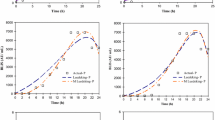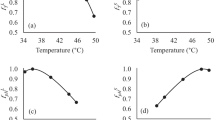Abstract
The use of bacteriocin-producing probiotics to improve food fermentation processes seems promising. However, lack of fundamental information about their functionality and specific characteristics may hinder their industrial use. Predictive microbiology may help to solve this problem by simulating the kinetics of bacteriocin-producing strains and optimising the cell growth and production of beneficial metabolites. In this study, a combined model was developed which could estimate, from a given initial condition of temperature and pH, the growth and bacteriocin production of Lactobacillus plantarum BC-25 in MRS broth. A logistic model was used to model the growth of cells, and the Luedeking-Piret model was used to simulate the biomass and bacteriocin production. The parameters generated from these primary models were used in a response surface model to describe the combined influence on cell growth, biomass and bacteriocin production. Both the temperature and pH influenced cell and bacteriocin production significantly. The optimal temperature and pH for cell growth is 35 °C and 6.8, and the optimal bacteriocin production condition is a range dependent on two growth-associated constants (YA/X and K), where temperature is from 27 to 34 °C, and pH is 6.35 to 6.65. The developed model is consistent with similar studies and could be a useful tool to control and increase the production of lactic acid bacteria in bioreactors.




Similar content being viewed by others
References
Klaenhammer, T. R. (1988). Bacteriocins of lactic acid bacteria. Biochimie, 70, 337–349.
Messens, W., Verluyten, J., Leroy, F., & De Vuyst, L. (2003). Modelling growth and bacteriocin production by Lactobacillus curvatus LTH 1174 in response to temperature and pH values used for European sausage fermentation processes. International Journal of Food Microbiology, 81, 41–52.
Messens, W., Neysens, P., Vansieleghem, W., Vanderhoeven, J., & De Vuyst, L. (2002). Modelling growth and bacteriocin production by Lactobacillus amylovorus DCE 471 in response to temperature and pH value used for sourdough fermentation. Applied and Environmental Microbiology, 68, 1431–1435.
Vignolo, G. M., Kairuz, M. N., Ruiz-Holgado, A. A. P., & Oliver, G. (1995). Influence of growth conditions on the production of lactocin 705, a bacteriocin produced by Lactobacillus casei CRL 705. Journal of Applied Bacteriology, 78, 5–10.
McMullen, L. M., & Stiles, M. E. (1996). Potential use of bacteriocin-producing lactic acid bacteria in the preservation of meats. Journal of Food Protection, 58, 64–71.
Leroy, F., & De Vuyst, L. (2003). A combined model to predict the functionality of the bacteriocin-producing Lactobacillus sakei. Applied and Environmental Microbiology, 69, 1093–1099.
Leroy, F., & De Vuyst, L. (2002). Bacteriocin production by Enterococcus faecium RZS C5 is cell density limited and occurs in the very early growth phase. International Journal of Food Microbiology, 72, 155–164.
Leroy, F., & De Vuyst, L. (1999). Temperature and pH condition that prevail during fermentation of sausages are optimal for production of the antilisteral bacteriocin sakacin K. Applied and Environmental Microbiology, 65, 974–981.
Gibson, A. M., Bratchell, N., & Roberts, T. A. (1988). Predicting microbial growth: growth responses of salmonellae in a laboratory medium as affected by pH, sodium chloride and storage temperature. International Journal of Food Microbiology, 6(2), 155–178.
Vazquez, J. A., & Murado, M. A. (2008). Unstructured mathematical model for biomass, lactic acid and bacteriocin production by lactic acid bacteria in batch fermentation. Journal of Chemical Technology & Biotechnology, 83, 91–96.
Parente, E., Ricciardi, A., & Addario, G. (1994). Influence of pH on growth and bacteriocin production by Lactococcus lactis subsp. lactis 140NWC during batch fermentation. Applied Microbiology and Biotechnology, 41, 388–394.
Isabelle, L., & Andre, L. (2006). Quantitative prediction of microbial behaviour during food processing using an integrated modeling approach: a review. International Journal of Refrigeration, 29, 968–984.
Ross, T. (1996). Indices for performance evaluation of predictive models in food microbiology. Journal of Applied Microbiology, 81, 501–508.
Leroy, F., & De Vuyst, L. (2005). Simulation of the effect of sausage ingredients and technology on the functionality of the bacteriocin-producing Lactobacillus sakei CTC 494 strain. International Journal of Food Microbiology, 100, 141–152.
Neysens, P., & De Vuyst, L. (2005). Kinetics and modelling of sourdough lactic acid bacteria. Trends in Food Science & Technology, 16, 95–113.
Motta, A. S., & Brandelli, A. (2003). Influence of growth conditions on bacteriocin production by Brevibacterium linens. Applied Microbiology and Biotechnology, 62, 163–167.
De Vuyst, L., Callewaert, R., & Crabbe, K. (1996). Primary metabolite kinetics of bacteriocin biosynthesis by Lactobacillus amylovorus and evidence for stimulation of bacteriocin production under unfavourable growth conditions. Microbiology, 142, 817–827.
Cladera-Olivera, F., Caron, G. R., & Brandelli, A. (2004). Bacteriocin production by Bacillus licheniformis strain P40 in cheese whey using response surface methodology. Biochemistry Engineering Journal, 21, 53–58.
Mataragas, M., Metaxopolous, J., Galiotou, M., & Drosinos, E. H. (2003). Influence of pH and temperature on growth and bacteriocin production by Leuconostoc mesenteroides L124 and Lactobacillus curvatus L442. Meat Science, 64, 265–271.
Zhang, J., Zhang, Y., Liu, S., Han, Y., & Zhou, Z. (2012). Modelling growth and bacteriocin production by Pediococcus acidilactici PA003 as a function of temperature and pH value. Applied Biochemistry and Biotechnology, 166, 1388–1400.
Delgado, A., Brito, D., Peres, C., Noe-Arroyo, F., & Garrido-Fernandez, A. (2005). Bacteriocin production by Lactobacillus pentosus B96 can be expressed as a function of temperature and NaCl concentration. Food Microbiology, 22, 521–528.
Guerra, N. P. (2014). Modeling the batch bacteriocin production system by lactic acid bacteria by using modified three-dimensional Lotka–Volterra equations. Biochemical Engineering Journal, 88, 115–130.
Chowdhury, B. R., Chakraborty, R., & Chaudhuri, U. R. (2007). Validity of modified Gompertz and logistic models in predicting cell growth of Pediococcus acidilactici H during the production of bacteriocin pediocin AcH. Journal of Food Engineering, 80, 1171–1175.
Acknowledgments
This research was supported by the Scientific Research Program of Sichuan Education Department and the Scientific Program from Education Office of Sichuan province (13ZA0265). We are also very thankful to S. George for her helpful English correction of this manuscript.
Author information
Authors and Affiliations
Corresponding author
Rights and permissions
About this article
Cite this article
Zhou, K., Zeng, Yt., Han, Xf. et al. Modelling Growth and Bacteriocin Production by Lactobacillus plantarum BC-25 in Response to Temperature and pH in Batch Fermentation. Appl Biochem Biotechnol 176, 1627–1637 (2015). https://doi.org/10.1007/s12010-015-1666-3
Received:
Accepted:
Published:
Issue Date:
DOI: https://doi.org/10.1007/s12010-015-1666-3




